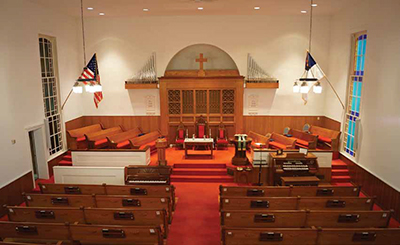To meet the needs of the First Presbyterian Church of Greenwood, SC, Hames Pro, based in Greenville, SC, installed three Vaddio WallVIEW 70 PTZ standard definition cameras and a Vaddio ProductionView FX console to both control and switch between the cameras.When it comes to AV integrators’ approach to the house of worship (HOW) market, size absolutely matters. The vaunted mega churches, with their significantly larger budgets and a willingness to try new technologies, look at AV in a much different way than their more diminutive counterparts.
But attracting smaller HOWs can nonetheless be a solid business silo for AV contractors. The common thread between all HOWs, beside the vital importance they place in their message, is the increasingly essential role of professional AV in their plans. Video serves a triplethreat function at HOWs, for example, allowing them to show the action of interest at the front of the sanctuary via IMAG (image magnification), through web streaming, and also through broadcasting in many cases.
“There is a trickle-down effect from larger HOW to smaller venues,” said Kelly Perkins, marketing and communications manager for Vaddio. “Typically, the mega churches are the first on the block to adopt the technology due to their size and advanced production requirements. It began with cassettes and moved to DVDs—now it’s getting streamed to the web.
“Streaming has created a whole new way of delivering a service’s message,” Perkins continued. “Now every HOW has a chance to create their own network. While streaming is being used for remote ministry, IMAG is being used for local display within the church.”
Here’s where smaller churches in particular begin to run into their own distinctive challenges, which AV contractors can help them puzzle out. “This goes back to: do they need to stream or broadcast their services or do they need IMAG?” Perkins pointed out. “A church that seats only 200 people doesn’t need IMAG, and in some cases video isn’t even necessary. Sometimes an audio system will work just fine. It just depends on the size of the church and what they ultimately would like to attain.”
At Illinois-based microphone manufacture Shure, Chris Lyons, manager of technical and educational communications, often senses a fundamental misperception when smaller HOWs are planning AV additions or upgrades. “Other than simple lack of funds, the biggest problem is that their vision is often driven by what they see: the hardware,” he noted. “In truth, ‘great AV’ is what happens when the appropriate products are properly installed by a knowledgeable integrator, and operated by a well-trained staff. Smaller churches are often eager to buy flashy new hardware, but are not willing to invest in the knowledge required to get the best out of it.”

Alexacdria First Presbyterian in Holland Township, NJ, enlisted Blackwood, NJ-based JD Sound and Video to install distributed HD video with multiple screens throughout and a sound system featuring Community ENTASYS column arrays and VLF series subwoofers.Pursuant to that, Lyons believes that part of the AV integrator’s mission is to keep small HOWs—with their largely volunteer staffs running the technical plant—on point when selecting their systems. “A more sophisticated AV system requires a more sophisticated operator,” he observed. “Make sure that the technology being added solves a problem that really exists, and doesn’t exceed the staff’s ability to make full use of it. Switching to wireless microphones for performers makes for a cleaner look and faster setup and teardown, but adds additional complexity in terms of frequency coordination and battery management that someone needs to stay on top of.”
Ken Swanton, vice president of marketing for Broadcast Pix, has a sense of when his systems will enter the small HOW AV picture. “We usually get involved with smaller congregations after they have experimented with simple video but want to add more inspirational content to their productions, such as multiple cameras, robotic cameras, animations, graphics, clips, and combinations,” he said. “One feature we have that helps them boost sophistication is our unique Fluent Macros technology, which lets a user setup a nice combination of elements and store it, so it can be recalled with one button push. Then, even a novice volunteer TD can use these macros to make their productions look surprisingly professional.”
Manufacturers have an increasing store of solutions that are ideal for HOW customers on this level. Shure’s upcoming BLX wireless system [available Summer 2013], and the BLX4R rack-mount receiver in particular, was designed for installed sound systems where economy and flexibility are equally important to sound quality and ease-of-use.
At Vaddio, a typical church system may consist of their ProductionVIEW HD or ProductionVIEW HDMV switcher/mixer/ camera controllers. These multitasking solutions allow users to hook up to six inputs—including PTZ Cameras, laptop, DVD player, and more, for video and display of presentations or lyrics. Meanwhile, Vaddio’s TeleTouch touchscreen monitors are optimal for church volunteers via the ability to control and switch inputs simply by touching the screen.
Broadcast Pix’s offerings include its Mica video production systems with recently added V3.1 software providing multi-screen support. “One Mica system can simultaneously produce up to three composited shows at once,” said Swanton, “so you can feed two screens in the sanctuary and produce a presentation for your web audience, for example. All three can be controlled by one operator when you are short-handed—but when you have lots of volunteers, they can each have their own control panel using soft panels on a laptop or iPad.”
As the cost of more sophisticated audio and video solutions continues to decrease, HOWs of every size know that they can afford the tools for a world-class presentation. In this vertical, AV integrators looking to gain a larger foothold will do it with superior service and support before, during, and long after the sale.
“Don’t try to oversell equipment they don’t need—and don’t try to sell them anything too complicated,” advised Vaddio’s Kelly Perkins on the approach to smaller HOWs. “Remember, most churches don’t have technical directors—the people running the AV equipment are volunteers who usually know nothing about AV. Simple, easy-to-use equipment is the way to go.”
“Building a long-term relationship is more important than ever,” concluded Shure’s Chris Lyons. “I still hear churches complain that ‘They sold us the system, and then we never heard from them again.’ Integrators who focus not only on the hardware, but ongoing training and maintenance, are the ones who will be called back when the church expands or moves to a new facility. And churches who have been ‘abandoned’ by an installer are an opportunity for a smart integrator to sort out a system, recommend inexpensive fixes, and be in place when it’s time to upgrade.”
David Weiss (www.dwords.com) writes extensively about AV, audio, and broadcast technology.
